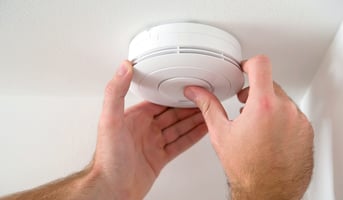Can a Gas Fireplace Cause Carbon Monoxide Poisoning?
Security Systems Oct 7, 2022 9:32:46 AM General Security 8 min read

Editor’s Note: This blog post was originally published in October 2018 and has been revised to reflect industry updates.
Carbon monoxide poisoning can severely damage the human nervous and respiratory systems, as well as the brain and heart. It can even be fatal if depriving the body of enough oxygen.
This dangerous gas poses a significant health risk to occupants in residential homes and commercial buildings, especially during cold weather, when gas fireplaces are frequently used.
According to a 2023 report from the Centers for Disease Control and Prevention (CDC), at least 420 Americans die each year from accidental carbon monoxide poisoning and more than 100,000 visit the emergency room for related incidents. Many of these deaths occur between December and February.
It’s essential to know what could potentially expose someone to this colorless, odorless, and tasteless gas.
Below we’ll discuss the dangers of carbon monoxide, as well as precautions that can protect your family, home, employees, and place of business.
Download Now! Free Home Safety Checklist
Carbon Monoxide Poisoning Causes & Symptoms
Yes, gas fireplaces are one potential cause of carbon monoxide poisoning.
While there are many potential sources of such exposure—including certain appliances and devices, motor vehicles, and wood stoves—gas fireplaces are a common culprit.
Carbon dioxide is a byproduct of the oxidation process occurring within the complete combustion of fossil fuels, which contain elemental carbon and hydrogen. An improperly maintained or ventilated gas fireplace can create incomplete combustion, producing carbon monoxide, and causing this toxic gas to linger—putting those inside at risk.
Several indications of carbon monoxide poisoning—whether from gas fireplaces or other sources—include, but are not limited to:
- Nausea
- Dizziness
- Shortness of Breath
- Chest Pain
- Headache
- Unconsciousness
According to the National Safety Council (NSC), a nonprofit dedicated to helping eliminate preventable deaths in the workplace, homes and communities, prolonged exposure can cause:
- Mental Confusion
- Vomiting
- Loss of Muscular Coordination
- Loss of Consciousness
- Death
Carbon monoxide poisoning can also be confused with the flu, since both share similar symptoms, depending on exposure duration. If you think you or someone you know has been exposed to carbon monoxide poisoning, contact a medical professional immediately.
Keep these precautions in mind if you have a gas fireplace in your home:
Conduct a Gas Fireplace Safety Check
To ensure your gas fireplace is free of gas leaks or other dangers, it’s important to perform the following safety checks:
- Open gas fireplace screens or doors for any foul smells. A rotten egg odor—or similar-type smell—is a definite leak indicator.
- Listen for hissing or whistling sounds.
- Look for any dust, dirt, or other debris at the fireplace base.
- Check for dead or yellowed grass and plants near outdoor gas lines.
- Perform a gas leak test to check: Mix 8 ounces of water and one to two teaspoons of liquid dish soap for application on gas lines and logs to check for bubbling.
Get Your Fireplace Inspected Every Year
Besides regularly cleaning your fireplace, it’s critical to hire a licensed and trained inspector to evaluate its condition, as well as your chimney. Any issues that could cause you or your loved ones harm will be immediately identified and remedied.
Blockages, structural damage, and dirty parts can all work to trap carbon monoxide and increase leakage instances. Your inspector will ensure vents aren’t blocked, and they will also check for damage, dirt and grime, and other red flags such as broken fireplace doors and clogged starters.
Besides preventative maintenance, there are other precautionary measures against carbon monoxide.
Invest in an Effective Smoke & Carbon Monoxide Detector
Having smoke and carbon monoxide detectors installed in your home is another step to safeguarding against this potentially deadly gas. A detector will alert if both carbon monoxide and smoke are present—protecting against fires, too.
The U.S. Consumer Product Safety Commission (CPSC) warns that a beeping carbon monoxide alarm must never be ignored, even if indicating a low battery or low charge, since both could cause device malfunction.
Examples include a beeping or chirping sound every 30 seconds to five minutes, which could indicate gas presence or a low battery. The device should be replaced immediately if either is present.
When listening for CO detector beeps, there are differences between frequencies and pauses. While these signals could alert a potential issue, it’s recommended to conduct further inspection.
Note the most common CO beeps and frequencies below:
- Four beeps accompanied by a pause signal CO presence. Occupants should immediately seek fresh air and notify emergency personnel.
- One beep per minute means CO detector batteries are due for replacement.
- Five beeps per minute indicate the detector has expired and should be replaced.
General Security recommends conducting regular device inspections and battery replacement during Daylight Savings Time—once when you spring ahead and again when you fall back.
The service provider supplying the smoke and carbon monoxide detector may also provide constant alarm monitoring to alert you, as well as the authorities, of any carbon monoxide or smoke in your home.
With the increasing popularity of smart home security, many providers will connect your smoke and carbon monoxide monitor directly to the security system, for real-time mobile app alerts and invaluable peace of mind.
Conduct Regular Chimney Sweeps & Inspections
Your chimney should be regularly inspected and swept so it’s clean and free of obstructions and damage. If not maintained properly, a blocked chimney could lead to carbon monoxide exposure from buildup of combustible gasses.
According to chimney repair company Northeastern Chimney LLC, it’s recommended to immediately consult a professional if you notice any the following issues:
- Water Streaking or Rusting on Your Chimney or Vent
- Missing or Loose Furnace Panels
- Soot Buildup
- Disconnected or Loose Chimney/Vent Connections
- Loose Chimney Masonry
- Less Available Hot Water
How Can I Tell if My Gas Fireplace Is Leaking?
We can’t reiterate this enough: Fireplaces, chimneys, and smoke and carbon monoxide detectors should be regularly inspected! It’s also important to watch for other possible carbon monoxide leak indicators in your home or place of business.
According to online home security research hub ASecureLife, these could include:
- Black, Sooty Marks on Fireplace Covers
- Sooty or Yellow/Brown stains on or Near Boilers, Stoves, or Fireplaces
- Smoke Buildup in Rooms
- Yellow [Instead of Blue] Flames Coming From Gas Appliances
- Pilot Lights Frequently Blowing Out
Gas Fireplace FAQs
Learn more about some of the most frequently-asked questions regarding gas fireplace safety. These include:
Can I leave my gas fireplace on overnight?
While it might be tempting to fall asleep near your gas fireplace on a chilly evening, it’s actually putting your family at higher risk for carbon monoxide poisoning, fire, and smoke inhalation. A vent-free gas fireplace with easily accessible front doors shouldn’t be operated more than three consecutive hours.
What should I check prior to turning on a gas fireplace?
Having your gas fireplace inspected annually is the best protection against carbon monoxide poisoning. Regularly checking blowers, glass doors, pilot lights, and carbon monoxide detectors is also recommended.
How can I tell if my gas fireplace isn't properly vented?
Smoke blowback will signify an improperly vented fireplace, which could occur from backdrafting, chimney flue blockages, and other dangers.
Why is there an odor emanating from my gas fireplace?
Upon its first yearly start, your gas fireplace could produce a plastic scent from dust, pet dander, and other collected particles. If this odor remains after at least two hours—or resembles gas—turn off your fireplace and contact a professional. This could signal a leak, faulty equipment, or other dangers.
How can I prevent carbon monoxide poisoning in my home or office?
Conducting regular inspections of gas fireplaces, chimneys, carbon monoxide detectors and smoke alarms, and frequent safety checks all help avoid carbon monoxide poisoning. If you’re unsure of how to properly assess any of these, enlist professional guidance.
Vigilance Is Key
Implementing these tips can ensure your home or business receives the highest protection levels regarding gas fireplace safety. Consult a professional security company offering additional tools and education.
General Security provides smoke and carbon monoxide detectors, and a variety of fire safety systems, services, and security systems, to homeowners and businesses throughout the U.S. East Coast. Request a free quote from us today!
Read the following blogs to ensure you’re up to date on the latest carbon monoxide monitoring measures:




